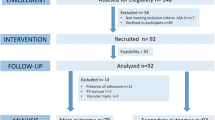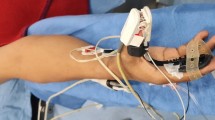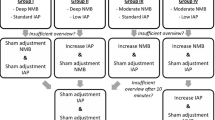Abstract
Background
Higher intra-abdominal pressure may impair cardiopulmonary functions during laparoscopic surgery. While 12–15 mmHg is generally recommended as a standard pressure, the benefits of lower intra-abdominal pressure are unclear. We thus studied whether the low intra-abdominal pressure compared with the standard pressure improves cardiopulmonary dynamics during laparoscopic surgery.
Methods
Patients were randomized according to the intra-abdominal pressure and neuromuscular blocking levels during laparoscopic colorectal surgery: low pressure (8 mmHg) with deep-block (post-tetanic count 1–2), standard pressure (12 mmHg) with deep-block, and standard pressure with moderate-block (train-of-four count 1–2) groups. During the laparoscopic procedure, we recorded cardiopulmonary variables including cardiac index, pulmonary compliance, and surgical conditions. We also assessed postoperative pain intensity and recovery time of bowel movement. The primary outcome was the cardiac index 30 min after onset of laparoscopy.
Results
Patients were included in the low pressure with deep-block (n = 44), standard pressure with deep-block (n = 44), and standard pressure with moderate-block (n = 43) groups. The mean (SD) of cardiac index 30 min after laparoscopy was 2.7 (0.7), 2.7 (0.9), and 2.6 (1.0) L min−1 m−2 in each group (P = 0.715). The pulmonary compliance was higher but the surgical condition was poorer in the low intra-abdominal pressure than the standard pressure (both P < 0.001). Other variables were comparable between groups.
Conclusion
We observed few cardiopulmonary benefits but poor surgical conditions in the low intra-abdominal pressure during laparoscopy. Considering cardiopulmonary dynamics and surgical conditions, the standard intra-abdominal pressure may be preferable to the low pressure for laparoscopic surgery.




Similar content being viewed by others
References
Madsen MV, Gatke MR, Springborg HH, Rosenberg J, Lund J, Istre O (2015) Optimising abdominal space with deep neuromuscular blockade in gynaecologic laparoscopy-a randomised, blinded crossover study. Acta Anaesthesiol Scand 59:441–447
Ozdemir-van Brunschot DM, van Laarhoven KC, Scheffer GJ, Pouwels S, Wever KE, Warle MC (2016) What is the evidence for the use of low-pressure pneumoperitoneum? A systematic review. Surg Endosc 30:2049–2065
Neudecker J, Sauerland S, Neugebauer E, Bergamaschi R, Bonjer HJ, Cuschieri A, Fuchs KH, Jacobi Ch, Jansen FW, Koivusalo AM, Lacy A, McMahon MJ, Millat B, Schwenk W (2002) The European Association for Endoscopic Surgery clinical practice guideline on the pneumoperitoneum for laparoscopic surgery. Surg Endosc 16:1121–1143
Suh MK, Seong KW, Jung SH, Kim SS (2010) The effect of pneumoperitoneum and Trendelenburg position on respiratory mechanics during pelviscopic surgery. Korean J Anesthesiol 59:329–334
Park JS, Ahn EJ, Ko DD, Kang H, Shin HY, Baek CH, Jung YH, Woo YC, Kim JY, Koo GH (2012) Effects of pneumoperitoneal pressure and position changes on respiratory mechanics during laparoscopic colectomy. Korean J Anesthesiol 63:419–424
Gurusamy KS, Vaughan J, Davidson BR (2014) Low pressure versus standard pressure pneumoperitoneum in laparoscopic cholecystectomy. Cochrane Database Syst Rev. https://doi.org/10.1002/14651858.CD006930.pub3
Koo BW, Oh AY, Seo KS, Han JW, Han HS, Yoon YS (2016) Randomized clinical trial of moderate versus deep neuromuscular block for low-pressure pneumoperitoneum during laparoscopic cholecystectomy. World J Surg 40:2898–2903
Martini CH, Boon M, Bevers RF, Aarts LP, Dahan A (2014) Evaluation of surgical conditions during laparoscopic surgery in patients with moderate vs deep neuromuscular block. Br J Anaesth 112:498–505
Dubois PE, Putz L, Jamart J, Marotta ML, Gourdin M, Donnez O (2014) Deep neuromuscular block improves surgical conditions during laparoscopic hysterectomy: a randomised controlled trial. Eur J Anaesthesiol 31:430–446
Staehr-Rye AK, Rasmussen LS, Rosenberg J, Juul P, Lindekaer AL, Riber C, Gätke MR (2014) Surgical space conditions during low-pressure laparoscopic cholecystectomy with deep versus moderate neuromuscular blockade: a randomized clinical study. Anesth Analg 119:1084–1092
Kim MH, Lee KY, Lee KY, Min BS, Yoo YC (2016) Maintaining optimal surgical conditions with low insufflation pressures is possible with deep neuromuscular blockade during laparoscopic colorectal surgery: a prospective, randomized, double-blind, parallel-group clinical trial. Medicine 95:e2920
Shuto K, Kitano S, Yoshida T, Bandoh T, Mitarai Y, Kobayashi M (1995) Hemodynamic and arterial blood gas changes during carbon dioxide and helium pneumoperitoneum in pigs. Surg Endosc 9:1173–1178
Perry Y, Reissman P, Blumental M, Lyass S, Pizov R (2003) Pressure-related hemodynamic effects of CO2 pneumoperitoneum in a model of acute cardiac failure. J Laparoendosc Adv Surg Tech A 13:341–347
Schnider TW, Minto CF, Gambus PL, Andresen C, Goodale DB, Shafer SL, Youngs EJ (1998) The influence of method of administration and covariates on the pharmacokinetics of propofol in adult volunteers. Anesthesiology 88:1170–1182
Minto CF, Schnider TW, Egan TD, Youngs E, Lemmens HJ, Gambus PL, Billard V, Hoke JF, Moore KH, Hermann DJ, Muir KT, Mandema JW, Shafer SL (1997) Influence of age and gender on the pharmacokinetics and pharmacodynamics of remifentanil. I. Model development. Anesthesiology 86:10–23
Boon M, Martini CH, Aarts LP, Bevers RF, Dahan A (2013) Effect of variations in depth of neuromuscular blockade on rating of surgical conditions by surgeon and anesthesiologist in patients undergoing laparoscopic renal or prostatic surgery (BLISS trial): study protocol for a randomized controlled trial. Trials 14:63
Kopman AF, Naguib M (2015) Laparoscopic surgery and muscle relaxants: is deep block helpful? Anesth Analg 120:51–58
Aldrete JA (1995) The post-anesthesia recovery score revisited. J Clin Anesth 7:89–91
Kang SB, Park JW, Jeong SY, Nam BH, Choi HS, Kim DW, Lim SB, Lee TG, Kim DY, Kim JS, Chang HJ, Lee HS, Kim SY, Jung KH, Hong YS, Kim JH, Sohn DK, Kim DH, Oh JH (2010) Open versus laparoscopic surgery for mid or low rectal cancer after neoadjuvant chemoradiotherapy (COREAN trial): short-term outcomes of an open-label randomised controlled trial. Lancet Oncol 11:637–645
Gommers D, Vilstrup C, Bos JA, Larsson A, Werner O, Hannappel E, Lachmann B (1993) Exogenous surfactant therapy increases static lung compliance, and cannot be assessed by measurements of dynamic compliance alone. Crit Care Med 21:567–574
Capron F, Alla F, Hottier C, Meistelman C, Fuchs-Buder T (2004) Can acceleromyography detect low levels of residual paralysis? A probability approach to detect a mechanomyographic train-of-four ratio of 0.9. Anesthesiology 100:1119–1124
Stuttmann R, Vogt C, Eypasch E, Doehn M (1995) Haemodynamic changes during laparoscopic cholecystectomy in the high-risk patient. Endosc Surg Allied Technol 3:174–179
Hein HA, Joshi GP, Ramsay MA, Fox LG, Gawey BJ, Hellman CL, Arnold JC (1997) Hemodynamic changes during laparoscopic cholecystectomy in patients with severe cardiac disease. J Clin Anesth 9:261–265
Kim JT, Kim HS, Lim YJ, Bahk JH, Lee KH, Kim CS, Kim SD, Jeon Y (2008) The influence of passive leg elevation on the cross-sectional area of the internal jugular vein and the subclavian vein in awake adults. Anaesth Intensive Care 36:65–68
Hofer CK, Zalunardo MP, Klaghofer R, Spahr T, Pasch T, Zollinger A (2002) Changes in intrathoracic blood volume associated with pneumoperitoneum and positioning. Acta Anaesthesiol Scand 46:303–308
Henny CP, Hofland J (2005) Laparoscopic surgery: pitfalls due to anesthesia, positioning, and pneumoperitoneum. Surg Endosc 19:1163–1171
Sefr R, Puszkailer K, Jagos F (2003) Randomized trial of different intraabdominal pressures and acid-base balance alterations during laparoscopic cholecystectomy. Surg Endosc 17:947–950
Kopman AF, Naguib M (2016) Is deep neuromuscular block beneficial in laparoscopic surgery? No, probably not. Acta Anaesthesiol Scand 60:717–722
Madsen MV, Staehr-Rye AK, Claudius C, Gatke MR (2016) Is deep neuromuscular blockade beneficial in laparoscopic surgery? Yes, probably. Acta Anaesthesiol Scand 60:710–716
Egawa H, Morita M, Yamaguchi S, Nagao M, Iwasaki T, Hamaguchi S, Kitajima T, Minami J (2006) Comparison between intraperitoneal CO2 insufflation and abdominal wall lift on QT dispersion and rate-corrected QT dispersion during laparoscopic cholecystectomy. Surg Laparosc Endosc Percutan Tech 16:78–81
Caesar Y, Sidlovskaja I, Lindqvist A, Gislason H, Hedenbro JL (2016) Intraabdominal pressure and postoperative discomfort in laparoscopic Roux-en-Y gastric bypass (RYGB) surgery: a randomized study. Obes Surg 26:2168–2172
Jones RK, Caldwell JE, Brull SJ, Soto RG (2008) Reversal of profound rocuronium-induced blockade with sugammadex: a randomized comparison with neostigmine. Anesthesiology 109:816–824
Murphy GS (2006) Residual neuromuscular blockade: incidence, assessment, and relevance in the postoperative period. Minerva Anestesiol 72:97–109
Geldner G, Niskanen M, Laurila P, Mizikov V, Hübler M, Beck G, Rietbergen H, Nicolayenko E (2012) A randomised controlled trial comparing sugammadex and neostigmine at different depths of neuromuscular blockade in patients undergoing laparoscopic surgery. Anaesthesia 67:991–998
Pühringer FK, Rex C, Sielenkämper AW, Claudius C, Larsen PB, Prins ME, Eikermann M, Khuenl-Brady KS (2008) Reversal of profound, high-dose rocuronium-induced neuromuscular blockade by sugammadex at two different time points: an international, multicenter, randomized, dose-finding, safety assessor-blinded, phase II trial. Anesthesiology 109:188–197
Schwarte LA, Scheeren TW, Lorenz C, De Bruyne F, Fournell A (2004) Moderate increase in intraabdominal pressure attenuates gastric mucosal oxygen saturation in patients undergoing laparoscopy. Anesthesiology 100:1081–1087
Button D, Weibel L, Reuthebuch O, Genoni M, Zollinger A, Hofer CK (2007) Clinical evaluation of the FloTrac/Vigileo system and two established continuous cardiac output monitoring devices in patients undergoing cardiac surgery. Br J Anaesth 99:329–336
Rajaram SS, Desai NK, Kalra A, Gajera M, Cavanaugh SK, Brampton W, Young D, Harvey S, Rowan K (2013) Pulmonary artery catheters for adult patients in intensive care. Cochrane Database Syst Rev. https://doi.org/10.1002/14651858.CD003408.pub3
Geisen M, Ganter MT, Hartnack S, Dzemali O, Hofer CK, Zollinger A (2017) Accuracy, precision, and trending of 4 pulse wave analysis techniques in the postoperative period. J Cardiothorac Vasc Anesth. https://doi.org/10.1053/j.jvca.2017.09.006
Cannesson M, Attof Y, Rosamel P, Joseph P, Bastien O, Lehot JJ (2007) Comparison of FloTrac cardiac output monitoring system in patients undergoing coronary artery bypass grafting with pulmonary artery cardiac output measurements. Eur J Anaesthesiol 24:832–839
Lorsomradee S, Lorsomradee S, Cromheecke S, De Hert SG (2007) Uncalibrated arterial pulse contour analysis versus continuous thermodilution technique: effects of alterations in arterial waveform. J Cardiothorac Vasc Anesth 21:636–643
Acknowledgements
We thank the Medical Research Collaborating Centre for their advices about the statistical analyses.
Funding
This study was supported in part by a research grant from Investigator-Initiated Studies Program of Merck Sharp & Dohme Corporation. The opinions expressed in this paper are those of the authors and do not necessarily represent those of Merck Sharp & Dohme Corporation.
Author information
Authors and Affiliations
Corresponding author
Ethics declarations
Disclosures
Kook Hyun Lee and Jeong-Hwa Seo received a research grant from Merck Sharp & Dohme Corporation (Grant No. 51350). Youn Joung Cho, Hyesun Paik, Seung-Yong Jeong, Ji Won Park, Woo Young Jo, and Yunseok Jeon have no conflicts of interest or financial ties to disclose.
Electronic supplementary material
Below is the link to the electronic supplementary material.
Rights and permissions
About this article
Cite this article
Cho, Y.J., Paik, H., Jeong, SY. et al. Lower intra-abdominal pressure has no cardiopulmonary benefits during laparoscopic colorectal surgery: a double-blind, randomized controlled trial. Surg Endosc 32, 4533–4542 (2018). https://doi.org/10.1007/s00464-018-6204-2
Received:
Accepted:
Published:
Issue Date:
DOI: https://doi.org/10.1007/s00464-018-6204-2




